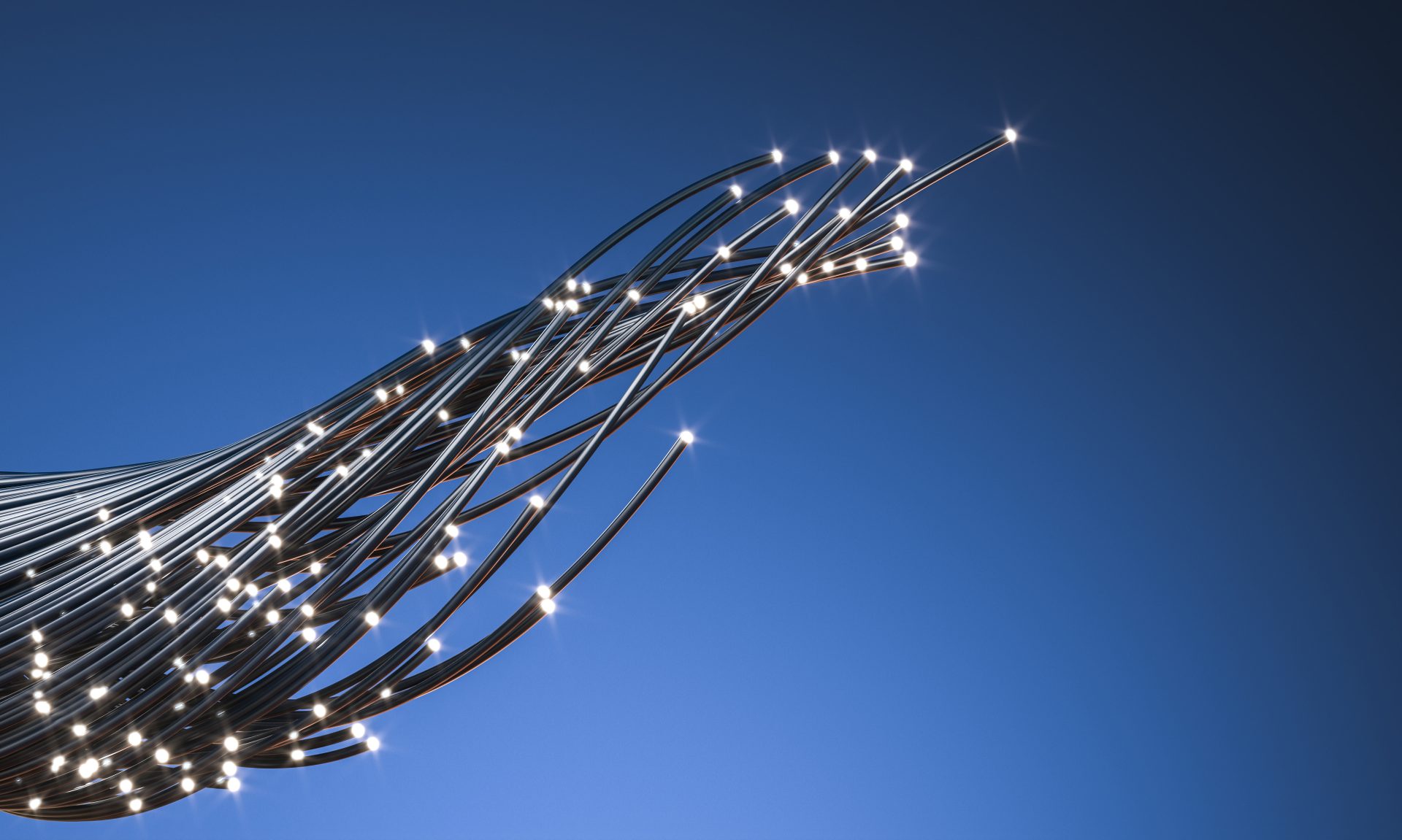It’s essential to select the correct fibre optic cable for a project. An incorrect choice will impact performance, reliability, and cost-effectiveness. So, how can you ensure you choose the best fibre optic cables for your specific needs?
Read our in-depth guide covering the importance of choosing the appropriate fibre cable for your project and the steps you should take before purchasing and installing.
Assessing The Differences Between Fibre Optic Cables

Optical fibre cables are comprised of bundles of glass fibres that carry data via light. They consist of three main components: the core, cladding, and protective jacket.
The core is optically pure glass or plastic, designed to guide light signals. The cladding reflects light into the core, while the protective jacket gives the cable strength and protection.
When searching for a cable solution, many people consider fibre optics or copper cables; however, the reliability and advanced capabilities optical fibre cables offer, such as higher bandwidth and faster data transfers, make them the better choice.
Two primary types of fibre optic cables are single-mode and multimode.
Single-mode cables have a small core, enabling long-distance transmissions with minimal signal loss, making them ideal for telecommunications and data centres. This cable offers high bandwidth but is more expensive than multimode cables.
Multimode cables have a larger core; they are a cost-effective solution for shorter distances and are commonly used in LAN (local area networks). This cable type has bandwidth limitations compared to single-mode cables, but they are a cheaper alternative.
Evaluate Your Project Requirements

As mentioned, the overall success of your project may be affected if you don’t choose the suitable fibre optic cable. For example, the results may not be long-lasting or be more costly than expected.
To avoid the above, consider the following factors before selecting a cable for your project:
Speed Of Data
- Understanding the data speed requirement of a project is critical to its success. So consider whether or not your project requires data delivered at high speeds.
Below are some industries that may require fast data transmissions.
1. Telecommunications
Fibre optic cables are the backbone of modern telecommunications networks, including long-distance telephone, internet, and data communication.
2. Data Centres
Data centres rely heavily on fibre optics to interconnect servers, switches, and storage devices. Fibre optics’ high data transfer rates and low latency enable efficient data processing and distribution.
3. Internet Service Providers (ISPs)
ISPs use fibre optic cables to provide high-speed broadband internet services to homes and businesses. Fibre-to-the-Home (FTTH) or Fibre-to-the-Premises (FTTP) connections deliver faster and more stable internet access than traditional copper-based connections.
4. Metropolitan Area Networks (MANs)
Fibre optic cables are used in MANs to connect multiple local area networks (LANs) within a city or metropolitan area. It enables high-speed data exchange between different locations.
5. Wide Area Networks (WANs)
WANs spanning long distances connect remote sites and branch offices with fibre optic cables. It ensures fast and reliable data transmission over extended distances.
6. High-Performance Computing
Industries such as scientific research, finance, and engineering often rely on fibre optics to interconnect high-performance computing clusters. Fibre cables provide the necessary bandwidth for handling massive data sets and complex calculations.
7. Video and Media Streaming
Fibre optic infrastructure is crucial for delivering high-definition video and media streaming services to consumers. It supports the rapid transfer of large data volumes required for seamless streaming.
8. Medical Imaging
In the medical field, fibre optics are used in medical imaging devices such as endoscopes and laparoscopes. They allow for high-resolution imaging and real-time transmission of images and video.
Bandwidth
- You should also think about your project’s bandwidth requirements. Projects with significant data demands need cables that can handle the capacity.
Distance
- As mentioned, different cables have varying capabilities regarding the distances they can transfer data. So consider your project’s transmission distance to understand whether you need a cable that handles long distances.
Environment
- The environmental conditions of your project should also guide you towards the type of cable to use. For example, assess whether your project will be exposed to harsh climates or chemicals; if the answer is “Yes”, you will need a ruggedly designed fibre optic cable, making it highly resistant to temperature extremes and other harmful elements.
Below are some practical examples of projects/environments and suitable fibre optic cable types.
Single-mode fibre optic cables are ideal for data centres needing high-speed data transfers and large bandwidth over long distances since they are considered effective long-distance fibre optic cables.
However, as we’ve already touched upon, local office LAN setups might favour cost-effective multimode cables if they don’t need to transfer data over long distances.
In industrial applications where communication occurs in harsh environments, rugged fibre optic cables with enhanced protection are essential, i.e. ones with an extra outer jacket.
How To Choose The Right Fibre Optic Cable For Your Project

Assess The Quality And Durability
Using high-quality, durable fibre optic cables ensures long-lasting performance and reliability in any project, minimising potential failures and downtime.
You should focus on critical features when assessing cable quality, such as tight manufacturing tolerances to maintain signal integrity and robust protective materials to withstand environmental challenges.
Adherence to industry standards also plays a crucial role. Ensure cables meet rigorous testing and certification processes, guaranteeing their reliability for mission-critical applications.
Installation Requirements
For a seamless and efficient installation process, you should consider factors like cable length, bend radius, and cable management.
The bend radius of a fibre optic cable can vary depending on the cladding and other factors; however, it is typically around ten times the diameter of the cable when not under tension. The bend radius tends to be twenty times the cable diameter under stress.
If your cable isn’t designed to bend to a certain degree, light can leak out, affecting your project’s performance.
Usually, installation routes are not linear, making route planning essential to understand the bend radius requirements of your project.
Route planning will also help you establish length requirements. Determine the length of cable you will need for the project and add on extra to avoid installing them too tightly.
Network Speed
Fibre optic cables are currently the best solution for data networking due to many factors, but mainly because of the high network speed they can deliver.
It is worth noting, however, that the speed of an optical fibre cable can be affected by the length of the cable; the further a light signal travels, the slower the speed.
With this in mind, your chosen cable must match your project’s required data transmission rates to avoid bottlenecks and maintain seamless data flow.
Selecting cables that support the desired network speed will ensure efficient data transfer and optimal system performance.
Also, consider future upgrades to accommodate evolving network requirements, allowing your project to adapt to changing demands.
Cost-Effectiveness
You must understand the importance of striking a balance between cost and performance when selecting fibre optic cables.
While cost is a significant consideration, opting for the cheapest option might compromise performance and reliability.
To make an informed decision, consider factors beyond the initial cable cost. For example, evaluate ongoing maintenance and the potential need for future upgrades.
Fibre optic cables can last up to 60 years if properly installed, reiterating the need to select the appropriate fibre optic cable for your project to fit them effectively.
Understand What Cables Are Best for Indoors and Outdoors
Indoor and outdoor fibre optic cables exhibit distinct characteristics based on their intended uses.
Indoor cables are designed for use within buildings and are typically more flexible to facilitate easy installation in confined spaces. They are fire-resistant as opposed to water-resistant, making them ideal for offices.
On the other hand, outdoor cables are ruggedised to endure harsh environmental conditions and designed to protect fibres from water and other elements related to the outdoors, such as rodents.
When selecting outdoor cables for your project, consider specific environmental factors like the level of moisture present, expected temperature fluctuations, UV radiation, and potential physical hazards.
Future Scalability
When selecting fibre optic cables, you should plan for future scalability.
A well-thought-out infrastructure design enables smooth network expansions or technology upgrades, ultimately saving you valuable time, money, and resources in the long run.
Fibre Optic Cable Products
Altimex offers various fibre optic cable products catering to diverse needs.
Our product line includes the following:
- Single-Mode Fibre (SMF) for projects that need to span long distances and offer high-speed transmissions.
- Multi-Mode Fibre (MMF) for shorter-range applications.
- For convenient connections, various Fibre Patch Cords, such as OM5 Fibre Multimode Patch Cords.
- Tight-buffered fibre cables, known as bulk fibre for added protection in indoor and outdoor installations.
- Universal Distribution Loose Tubes for easy access and termination.
With this comprehensive selection, Altimex provides solutions for different project requirements, ensuring reliable and efficient communication systems.
Tips For Installing Fibre Optic Cables

Once you choose the suitable cable for your project, it’s time to install it.
As mentioned, a correctly installed fibre optic cable can increase the longevity of your project’s life, making it essential to follow the appropriate installation steps.
See below our tips to help you install fibre optics.
1. Plan Your Installation
Thorough planning is of utmost importance before commencing the installation process.
Create a detailed installation plan encompassing cable routing, termination points, and the required equipment and tools. As already mentioned, a route plan will help you establish the cable you need.
Conducting a comprehensive site survey is crucial to identifying potential obstacles, hazards, or environmental factors that could impact the installation.
Ultimately, planning will help minimise risks and ensure your project’s effectiveness and reliability.
2. Test Your Fibre Optic Cables
You must test your fibre optic cables before and after installation to guarantee optimal performance. Testing will also help you identify any potential issues.
Utilise specialised fibre optic testing equipment, like an OTDR (Optical Time-Domain Reflectometer), which verifies signal integrity and detects signal losses or reflections.
By performing these tests diligently, you can ensure the reliability and efficiency of the installed cables, making sure that the system operates flawlessly or that you can promptly address any issues that arise.
3. Avoid Bending Or Twisting Your Cables
Be aware of the significance of maintaining proper bend radius for fibre optic cables to prevent signal loss and minimise the risk of cable damage.
Fibre optic cables are made of glass, so although strong, they are also easily breakable if mishandled.
As mentioned previously, the bend radius differs from cable to cable, so adhere to specific bend radius guidelines based on your cable type.
4. Don’t Mix The Wrong Fibre Optic Cables
Avoid mixing different types of fibre optic cables within the same network or installation. Simply put, don’t mix single-mode and multimode fibre optics.
Combining cables with varying core sizes or transmission capabilities can result in compatibility issues and signal degradation.
Label and colour-code the cables for easy identification to ensure a smooth installation process and simplify future maintenance and troubleshooting efforts.
5. Avoid Excessively Pulling Your Fibre Optic Cables
The primary cause of optical fibre cables breaking is excessive pulling. It is because they only have a particular tension capability and pull load.
Use a load monitor to help you assess whether you’re pulling too hard.
If you’re running your cable vertically, start at the top and pull it downwards.
6. Safely Support Your Fibre Optic Cables
Because glass fibres are fragile and as thin as human hair, you must adequately support them to safeguard them from potential damage caused by vibration, tension, or accidental tugging. In other words, don’t leave your fibre optic cables hanging loosely.
Use suitable cable trays, supports, and cable ties designed explicitly for fibre optic installations to maintain the integrity of the cables and mitigate the risk of costly repairs.
Additionally, conduits will support your fibre optic cables, whether you have installed them vertically or horizontally, as well as protect them against sharp objects.
Now you understand the type of fibre optic cable you need for your project and how to install it safely.
To conclude, the fibre optic cable you choose can make or break your project. You need to understand the result you want to achieve and the fundamental factors surrounding the installation site to ascertain the cable you require.
If you have questions regarding optical fibre cables or Altimex’s services, contact us today. We have over 25 years of experience and provide a range of services, including fibre optics, electronics, and lighting.
Frequently Asked Questions
Are fibre optic cables cheaper than copper cables?
Fibre optic cables tend to incur higher initial costs than copper cables, primarily attributed to the costs associated with manufacturing and the materials used. However, these higher upfront investments can be offset by the long-term cost-effectiveness of fibre optics.
The inherent advantages of optical fibre cables, such as their reduced maintenance needs, extended lifespan, and lower energy consumption, make them a financially beneficial choice in the long run compared to copper cables.
Project-specific requirements play a pivotal role in assessing the cost-effectiveness of fibre optic versus copper cables. You should carefully consider factors like data transmission speed, distance limitations, and environmental conditions of the installation site.
By thoroughly evaluating these factors, you can determine the most suitable and cost-effective solution between the two cable types, ultimately ensuring an optimal balance between upfront expenses and long-term savings.
What are the advantages of fibre optic cables?
Fibre optic cables boast remarkable advantages over traditional copper cables, mainly due to their high bandwidth capabilities. With the ability to handle large volumes of data at exceptionally high speeds, fibre optics have become the preferred choice for data transmission, offering unparalleled efficiency and performance.
Another remarkable feature of fibre optic cables is their immunity to electromagnetic interference, setting them apart from their copper counterparts.
In environments where electrical noise or radio frequency interference is prevalent, fibre optics maintain a stable and reliable data transmission, ensuring uninterrupted communication and optimal data integrity.
Furthermore, fibre optic cables excel in long-distance transmission without signal degradation. This characteristic makes them exceptionally well-suited for applications requiring extensive communication over considerable distances, such as long-haul networking and intercontinental data transfer.
Can fibre optic cables run above the ground?
Yes, fibre optic cables can be installed above the ground.
It is a common practice to place them on utility poles or aerial cable trays in outdoor environments.
You must implement proper protective measures to ensure their durability and resilience against various environmental factors.
You should employ armoured or ruggedised cables to shield them from the effects of weather, UV radiation, and potential physical damage, ensuring the longevity and reliability of the fibre optic infrastructure.
How can I determine data transmission speed and bandwidth requirements for my project?
To effectively plan for the project’s data transmission, it is crucial to analyse the data usage patterns comprehensively.
This involves scrutinising the data types being transmitted, the frequency of data transfers, and peak data loads to determine the exact data transmission speed requirements.
By understanding these usage patterns, you can equip your project with an optimised bandwidth solution that meets its current demands.
Moreover, future scalability must be taken into account during the planning process. Anticipating potential growth and technological advancements is essential to avoid the need for costly upgrades in the future. Selecting a bandwidth capacity that readily accommodates the project’s evolving needs ensures a flexible and future-proof solution.
What are the advantages of single-mode fibre optic cables compared to multimode cables?
Single-mode and multimode fibre optic cables have differing characteristics that suit applications and environments.
Single-mode fibre is highly advantageous for longer transmission distances, as it enables signals to travel significantly farther than multimode cables without experiencing considerable signal degradation. This attribute makes single-mode fibre preferred for long-distance communication and more extensive network infrastructures.
In addition to its extended transmission capabilities, single-mode fibre offers higher bandwidth capacity. This allows for faster data transmission rates and the ability to support data-intensive applications with lower latency, making it well-suited for scenarios where speed and efficiency are crucial.
On the other hand, multimode fibre cables are a more cost-effective alternative, mainly if transferring data over long distances isn’t necessary.
How do I ensure compatibility between the chosen fibre optic cable and my existing infrastructure?
Check Connector Types:
Verify that the connectors on the chosen fibre optic cable match those on the existing infrastructure. Common connector types include LC, SC, ST, and MTP/MPO. Ensuring compatibility will allow a seamless connection between the new cable and the existing components.
Match Fibre Type:
Confirm that the new fibre optic cable’s core size and mode (single-mode or multimode) align with the existing infrastructure. Mismatched fibre types can result in signal loss and performance issues.
Evaluate Transmission Speed and Bandwidth:
Assess the existing network’s transmission speed and bandwidth requirements and select a fibre optic cable that can support the same or higher data rates. Choosing a cable with inadequate capacity can limit the network’s overall performance.
Should I consult with professionals in the field before making my final fibre optic cable selection?
Obtaining expert advice from professionals in the field of fibre optic cables proves invaluable when making informed decisions for a project. Their extensive knowledge and experience allow them to offer valuable insights and tailored recommendations based on specific project requirements. This ensures the selection of the most appropriate cable type, effectively meeting the project’s data transmission needs and objectives.
Moreover, seeking expert advice helps mitigate potential risks that could adversely impact the project’s success. The risk of making costly mistakes, such as choosing incompatible cables or underperforming solutions, is minimised by consulting with professionals.
If you want to know how to choose a fibre optics manufacturer for your project, look no further.
Altimex provides a broad range of services, including fibre optic services, electronics manufacturing, and lighting solutions.


